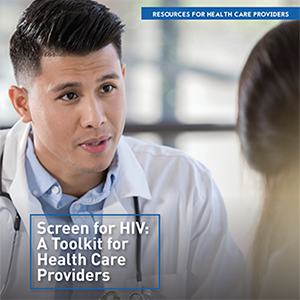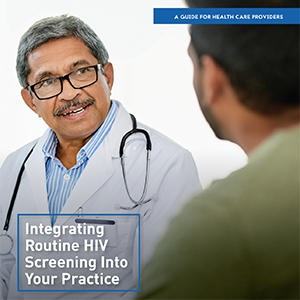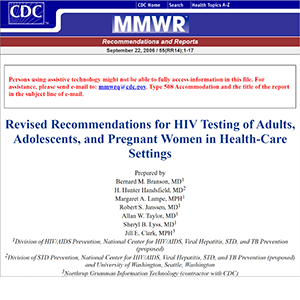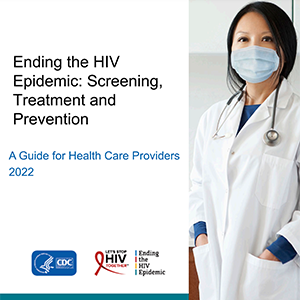How Do I Screen for HIV?
- The Centers for Disease Control and Prevention (CDC) recommends all patients between the ages of 13 and 64 get tested for HIV at least once as part of routine health care.
- Try conversation starters to talk with your patients about routine HIV screening.
- Screen patients who may be at ongoing risk for HIV at least annually.
- Use an “opt-out” approach to remove the stigma associated with HIV testing and foster earlier diagnosis and treatment.
- Know your state’s HIV testing laws and regulations.
HIV crosses the boundaries of gender, sexual orientation, age, and ethnicity. More than 1 million people in the United States have HIV, and many are unaware of their status. About 40% of new HIV infections are transmitted by people whose HIV is undiagnosed and who are unaware they have HIV.1
Diagnosing HIV quickly and linking people to treatment immediately are crucial to reducing new HIV infections.1 Individuals between the ages of 13 and 64 should be tested for HIV at least once as part of routine health care.
- HIV is a serious health disorder that can be detected before symptoms develop.
- HIV is detectable by reliable, inexpensive, acceptable screening tests.
- People diagnosed with HIV have years of life to gain if treatment is started early, before symptoms develop.
- Screening costs are reasonable in relation to proven benefits.
Offering HIV screening to all your patients helps to eliminate any stigma associated with HIV testing and creates opportunities to foster discussion about sexual health, risk factors, and overall health. The images below are examples of how you can start the conversation with your patients about routine HIV screening.
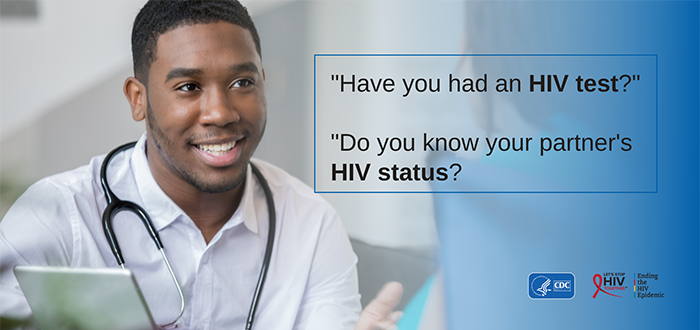
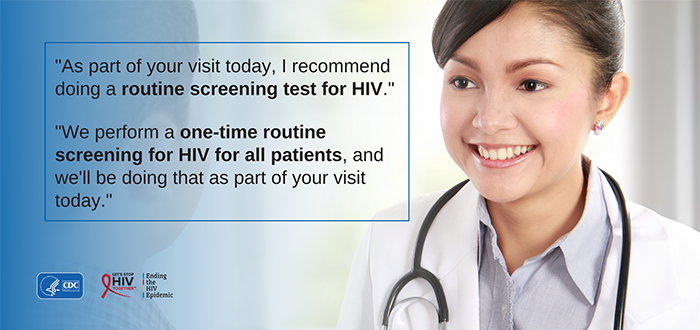
Patients who may be at increased risk for HIV should be screened at least annually.2, 3 Those likely to be at greater risk include:
- People who inject drugs and their sex partners.
- People who exchange sex for money or drugs.
- Sex partners of people with HIV.
- Sexually active gay, bisexual, and other men who have sex with men (more frequent testing may be beneficial [e.g., every 3–6 months]).
- Heterosexuals who themselves or whose sex partners have had ≥1 sex partner since their most recent HIV test.
- People receiving treatment for hepatitis, tuberculosis, or a sexually transmitted infection.
An HIV risk assessment should be included as part of routine primary care visits for all your sexually active patients to assess the needs for more frequent screening and prevention counseling.
- Prevention counseling may also be needed for your patients at greater risk for acquiring HIV but should not be required for general testing.
- People receiving treatment for hepatitis, tuberculosis, or a sexually transmitted infection may be at risk for HIV.
- People who inject drugs are also at risk for HIV. Heroin use has increased substantially in recent years. The heroin and prescription opioid epidemics have led to new HIV outbreaks.4,5 Routine screening offers you an opportunity to screen patients who may be reluctant to discuss or disclose risk factors.
CDC’s HIV Risk Reduction Tool shows the HIV risk of various sexual activities when one partner has HIV and the other doesn’t. It also provides tailored information to help your patients understand their risk for getting HIV and how to reduce their risks.
Risk-based screening may fail to identify persons with HIV, including women, members of minority races/ethnicities, nonurban dwellers in low-incidence areas, people under 20 years of age, and heterosexual men and women who are unaware of their risk of HIV. As a result, many people with HIV are not diagnosed until they have advanced HIV or AIDS. Routine, opt-out screening has proven to be highly effective because it:
- Removes the stigma associated with HIV testing.
- Fosters earlier diagnosis and treatment.
- Reduces risk of transmission.
- Is cost-effective.
When an opt-out approach is implemented, inform your patients (e.g., through a patient brochure, practice literature/form, or discussion) that an HIV test will be included in the standard preventive screening tests and that they may decline the test (opt-out screening).2 A patient’s decision to decline testing should be noted in their medical record. HIV prevention counseling is not a requirement for HIV testing.
HIV testing laws vary from state to state. Some state laws require that health care providers offer all patients a voluntary (opt-out) HIV test. Each state also has specific HIV test reporting laws and regulations. Your state may also require that the partner(s) of a patient who tests positive for HIV be notified of the patient’s HIV diagnosis. For the most up-to-date details on your state’s HIV testing laws and policies, consult CDC’s online resource on state laws affecting HIV prevention efforts or contact your health department.
Routine HIV screening is endorsed by:
1 Centers for Disease Control and Prevention. Estimated HIV incidence and prevalence in the United States 2015–2019. HIV Surveillance Report: Supplemental Report. 2021;26(1). https://www.cdc.gov/hiv/pdf/library/reports/surveillance/cdc-hiv-surveillance-supplemental-report-vol-26-1.pdf
2 Branson B, Handsfield HH, Lampe MA, et al. Revised recommendations for HIV testing of adults, adolescents, and pregnant women in health-care settings. MMWR Morb Mortal Wkly Rep. 2006;55(RR14):1-17. https://www.cdc.gov/mmwr/preview/mmwrhtml/rr5514a1.htm
3 DiNenno EA, Prejean J, Irwin K, et al. Recommendations for HIV screening of gay, bisexual, and other men who have sex with men – United States, 2017. MMWR Morb Mortal Wkly Rep. 2017;66(31):830-832. https://www.cdc.gov/mmwr/volumes/66/wr/mm6631a3.htm
4 Centers for Disease Control and Prevention. CDC Vital Signs: HIV and injection drug use. Published December 2016. Accessed June 28, 2018. https://www.cdc.gov/vitalsigns/pdf/2016-12-vitalsigns.pdf
5 Substance Abuse and Mental Health Services Administration. Results from the 2013 national survey on drug use and health: summary of national findings. Accessed June 28, 2018. https://www.samhsa.gov/data/sites/default/files/NSDUHresultsPDFWHTML2013/Web/NSDUHresults2013.pdf
